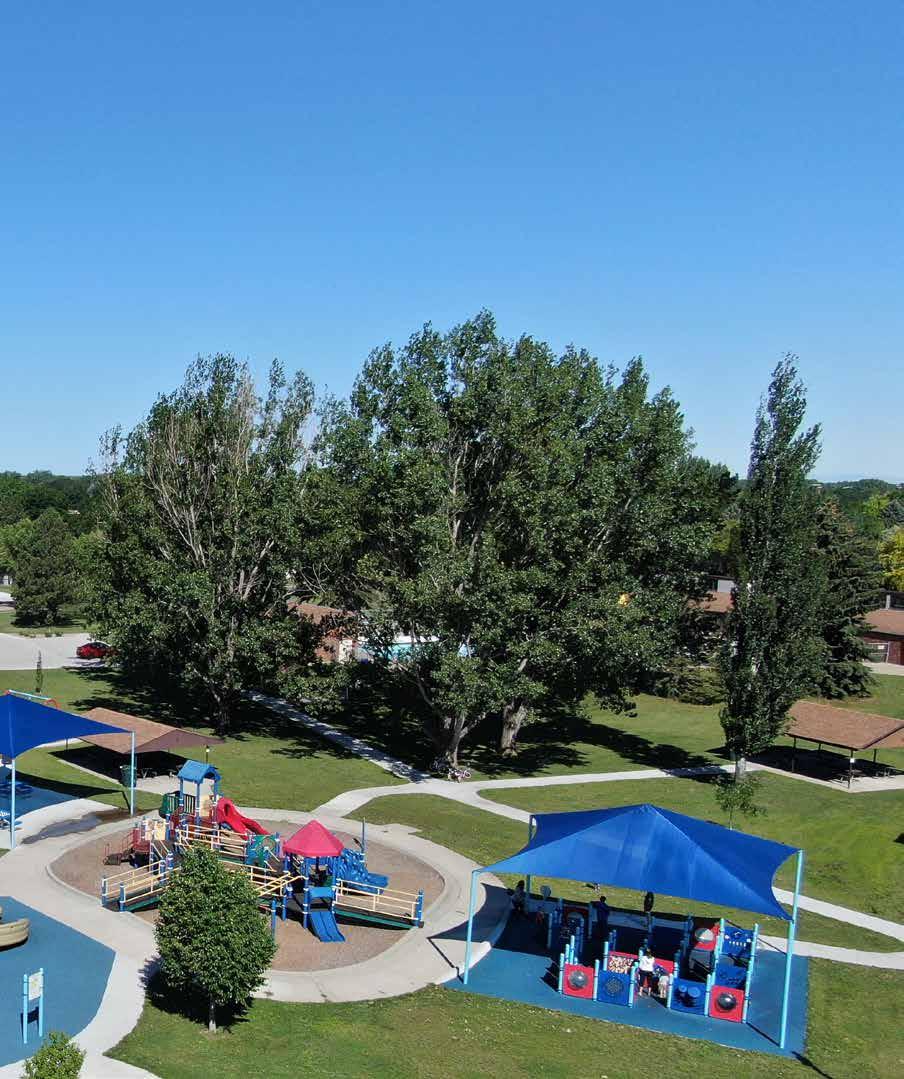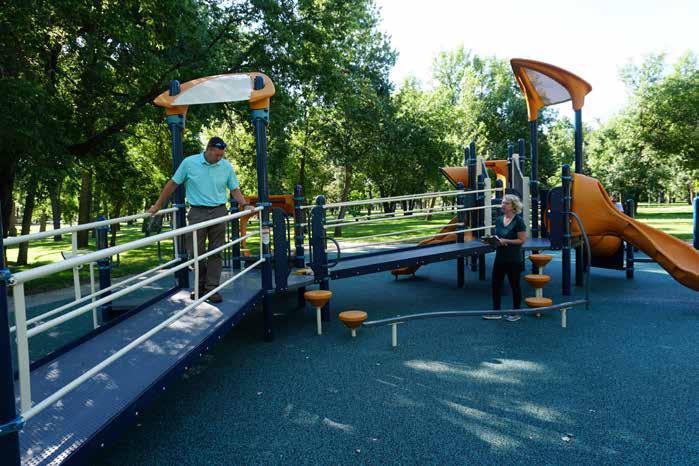
8 minute read
The Future of Playgrounds and Playground Safety
By Randy Bina, CPRE
An aerial view of Magical Moments Playground in Wachter Park, an awardwinning inclusive playground area designed by a group of local citizens who wanted to create a park where everyone could play together.
Advertisement
“Go outside and play.” Those wise words are uttered by nearly every parent since the beginning of time. Very wise words, indeed, especially when you consider the benefits of breathing fresh air, exploring the environment, experiencing hands-on learning and making new friends. Being able to move, touch, see and feel the outdoors stimulates children’s senses. Plus, it’s just plain fun!
“Go outside and play,” however, took on a new meaning in March 2020, when new terms dominated our lives, the landscape and headlines. “Pandemic,” “unprecedented,” “quarantine” and the much-dreaded “closed” have become part of our daily lexicon.

Closing recreational facilities, parks, trails and playgrounds goes against the grain and passion of every park and recreational professional. Denying services, turning off lights and fencing off play spaces are not our purpose — not ever. However, the governor’s orders, city restrictions and guidance from the Centers for Disease Control and Prevention (CDC) became the order of the day.
For Bismarck Parks and Recreation District (BPRD) in Bismarck, North Dakota, being ordered by Governor Doug Burgum to close indoor spaces, like fitness centers and community centers, was unsettling to the staff. However, we respected his executive orders and closed our indoor facilities.
A wave of questions centered on outdoor spaces ensued. Was playing outside safe? Could families go to a park? Could people walk on the trails? Were playgrounds safe?
From the very start, Governor Burgum focused on the value of outdoor recreation and its impact on North Dakotans’ physical and mental health. School was canceled, businesses closed, families were navigating distance learning, unemployment checks and payroll assistance checks were sought out — but amid all the chaos, people could still go outside. Outdoor opportunities became even more essential. The governor reminded all residents to focus on facts, not fear.
BPRD made the decision to keep parks, trails, sports complexes, fishing ramps and playgrounds open. Communication, especially in uncertain times, remains key. We shared news that outdoor spaces were open on the BPRD website and on all social media platforms. Staff were trained on safe practices and ways to answer citizens’ inquiries.
Within days, signs were placed at every sports complex and playground throughout the district with tips on staying safe, being physically distanced, wiping down equipment with sanitary wipes and using hand sanitizer when finished. BPRD focused on personal accountability and decision making. Playgrounds were open.

A sign displaying COVID-19 playground safety tips is posted at a playground in Sertoma Park.
Playgrounds Are More Important than Ever
In Bismarck, playgrounds have historically rated as one of the toprequested park features on all public input surveys. That data, however, was gathered in a pre-pandemic era. Today, the importance and benefits of outdoor play spaces is even more critical. The pandemic made parks and playgrounds a safe place for wellness.
The list of playground benefits got longer, as a result of the coronavirus (COVID-19) pandemic. A healthy, active body has more immunity. Play and physical activity can potentially relieve stress and anxiety for children and their caregivers. Being outdoors and playing safely could provide some welcome relief from the kitchen table/school desk. Time outdoors is a natural mood booster and mental health tonic that can be enjoyed by children of all ages and abilities.
Playgrounds became a new tool for community discovery. People wandered a bit further from their neighborhood park to find playgrounds they hadn’t visited before. There were plenty of options, as BPRD oversees 52 playgrounds in 60 parks. There are a variety of playgrounds with special amenities, including ramps, musical play panels, sensory input panels and sand-and-water features that are accessible to all.
BPRD uses themes in playground design to promote longer play times

and offer an opportunity for children to use their bodies and their imaginations. Yes, you can blast off into space at the rocket ship playground. Yes, you can go to the ball in that horse-drawn carriage. Yes, little cowboys and cowgirls, come aboard the stagecoach at Fort Fun. Other playground themes in the BPRD system center around construction, a fire truck and fire station, music, bugs and monkeys. BPRD has a total of 14 themed playgrounds.
Play Spaces for All
BPRD has a long history of creating inclusive and accessible playgrounds. Magical Moments Playground in Wachter Park is an award-winning inclusive playground area that was designed in 2006 by a group of local citizens who wanted to create a park where everyone could play together. The main champion of the play area was a parent of a child with severe disabilities, including Cerebral palsy, seizures, asthma and a vision impairment. The playground design was created by a committee of stakeholders, including parents of kids with disabilities, physical therapists, BPRD and children from local schools.
Magical Moments set the bar very high for inclusive playgrounds. That playground was updated and expanded in 2017. The playground includes a toddler area on a pouredin-place rubber surface, a sensory playground for ages 2 to 5 and an
BPRD Operations Director David Mayer and Park Planner Wendy AndersonBerg perform a safety audit of a new playground in Sertoma Park.

area for ages 5 to 12 with an extensive ramp system allowing for all modes of access, including those with mobility impairments. The playground also features a maze area, a sand play space with an accessible sand table and a dual zipline. The swings area provides accessible options and a molded ADA swing seat. In addition, BPRD has an extensive playground replacement program, where all playgrounds are evaluated on an annual basis and plans for their replacement become part of the budgeting process.
Since 2014, BPRD has installed 11 new playgrounds — nine in new neighborhood parks and two in a community park expansion. A total of 13 playgrounds have been replaced in that same timeframe.
Fortunately, the pandemic didn’t stop the installation or opening of new playgrounds. In July 2020, BPRD opened a fully inclusive playground with a poured-in-place surface, a large, inclusively designed play structure and a double zipline structure with accessible seating. The playground also includes a trail connection to the existing BPRD trail system. Shouts of “Wow!” and “Whoa!” often float through the park. At this writing, BPRD announced that another new playground, with poured-in-place surfacing and a large climbing structure, would open in late summer 2020 — the first playground of its kind in the area.
One of BPRD’s themed playgrounds, a rocket ship, allows children to use their imagination to travel to space.
Playground Safety with a New Perspective
The concept of playgrounds being accessible so that all kids and caregivers can get outside to play is paramount when BPRD begins the playground planning process. The BPRD Mission, to work with the community to provide residents and visitors with the highest quality park, program, facility and event experience, guides this process.
BPRD’s core purpose is to provide affordable, accessible and sustainable public park and recreation services. The “accessible” and “sustainable” pieces of that core purpose took on additional meaning as a result of the pandemic. In addition to providing playgrounds for all ages and abilities, “accessible” now means that we strive to keep playgrounds as safe as possible through new processes and increased awareness. “Sustainable” now means that we do everything we can to keep kids and caregivers safe and healthy, so that playgrounds can continue to stay open and provide that necessary social and physical outlet for the community.
Increased use of playgrounds meant that BPRD staff also needed to increase the frequency of inspections. Trained Certified Playground Safety Inspectors (CPSIs) examine playgrounds every other week with a low-frequency inspection at the beginning of the month. The lowfrequency inspection includes a very close look at all the nuts and bolts of the playground, looking for wear and tear, and any safety concerns. The high-frequency inspection is completed in the middle of the month. In addition, if BPRD receives any calls about a playground concern, the CPSI will inspect it right away. All inspections and safety concerns are addressed and recorded.
In addition to the regularly scheduled safety repairs and maintenance checks of the playground, BPRD staff also inspect the playground for cleanliness. The safety signs placed at the playgrounds were also inspected to make sure they were holding up to changes in the weather and they were visible to visitors.
BPRD embraces playground safety by supporting and continually enrolling staff in the CPSI program. The training for this nationally recognized mark of excellence has been hosted in Bismarck since the early 1990s through the National Recreation and Park Association and the North Dakota Recreation and Park Association. Twenty-three percent of the total BPRD staff are CPSIs. This ensures that BPRD is providing the safest playgrounds possible to the community and the members it serves.
The pandemic was a reminder that BPRD’s community-based research and the planned approach to adding, replacing and maintaining outdoor spaces, including playgrounds, made a difference and provided great rewards. Playgrounds support BPRD’s vision: Be the leader and premier provider of public parks, programs, facilities and leisure services.
The pandemic taught all park and recreation professionals additional lessons, including the ability to make adjustments and decisions based on community needs and expectations, to be able to pivot and move forward, to trust the guidance provided by health experts, to be able to provide new training opportunities to staff, and to collaborate based on local context and local conditions.
The pandemic also taught us that we need playgrounds. So, “Go outside and play.”
The pandemic taught all park and recreation professionals additional lessons, including the ability to make adjustments and decisions based on community needs and expectations, to be able to pivot and move forward, to trust the guidance provided by health experts, to be able to provide new training opportunities to staff, and to collaborate based on local context and local conditions.
Randy Bina, CPRE, is Executive Director at Bismarck Parks and Recreation District (BPRD) in Bismarck, North Dakota (RBina@bisparks.org).









